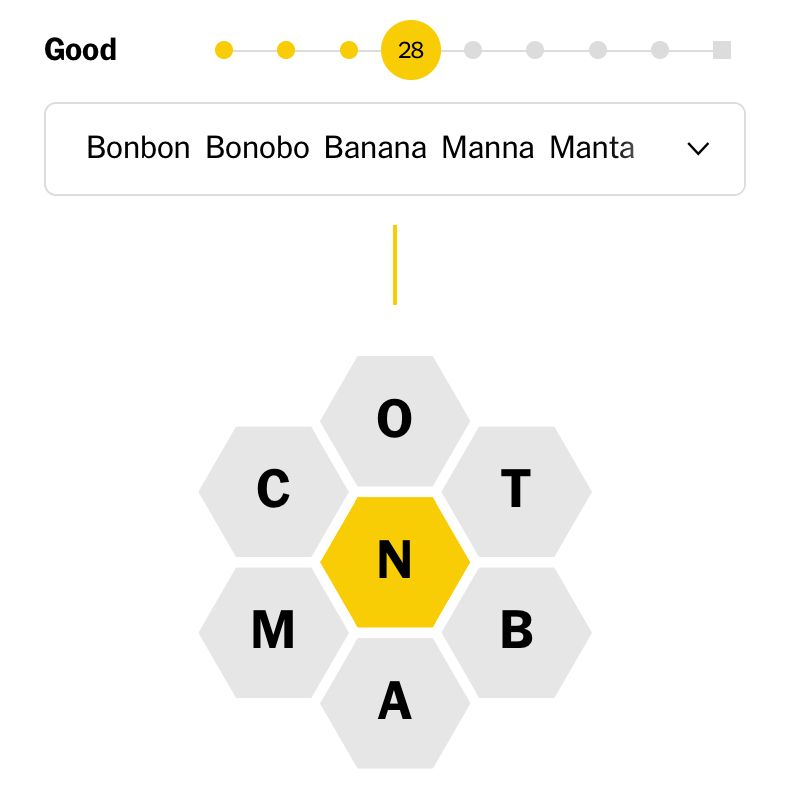

Beyond Wordle: All the New York Times' Games, Explained.Wordle Explained: Everything You Need to Know About the Viral Word Game.
#Spelling bee nytimes free
Note that while Wordle is free on the New York Times site - at least for now - the New York Times Spelling Bee is more complicated. If you find all the possible words, you're rewarded with the title of "Queen Bee." Or, uh, so I hear. The game reminds me of a childhood favorite, Boggle, minus the little lettered dice and fun-to-shake game tray, but with all the setup and scoring done for me.Īs you find words, the puzzle praises you with such compliments as "genius" or "amazing" and moves your score up a little line giving you higher ranks as you progress. There's always one pangram, which means a word that uses all seven of the letters and counts for big points. Players need to make words of four or more letters using the given letters, and always have to include the center letter. The rules are pretty simple: Each day offers up seven letters arranged in a honeycomb shape (honeycomb, spelling BEE, somebody on the Times design staff got a buzz out of that). The NYT Spelling Bee has been around since 2014 in print and since 2018 online. My absolute favorite is The New York Times Spelling Bee. Wordle isn't the only word game worth mastering - CNET has recommended a number of others. ^ "Paraulògic, el joc lingüístic online que s'ha fet viral"."Què és el Paraulògic, el joc lingüístic que ha revolucionat Twitter?". "How the Hivemind Conquers Spelling Bee". "The Decade in New York Times Crosswords and Games".

"The New York Times Spelling Bee game makes sense during these scrambled times". "Style Invitational Week 1424: We Bee back - a neologism contest".

The website, called Paraulògic, went viral in Catalonia a month after its launch. The same concept was adapted to the Catalan language by a non-profit in November 2021. Several online tools have been created to provide daily hints and analysis of the puzzle, among them one by science fiction author William Shunn. In addition to its reception among critics, the game has also spawned a significant following on social media, with players posting their scores and discussing each day's word selections on Twitter. Jim Memmot of the Rochester Democrat and Chronicle similarly praised the game as a pleasant pastime during the COVID-19 pandemic. Nilanjana Roy of the Financial Timespraised the game as one of the best ways to pass the time and connect with friends during the COVID-19 pandemic lockdowns. Pat Myers of The Washington Postwrote that, despite being a lifelong promoter of The Washington Post, she found herself in "the thrall of the New York Times Spelling Bee game". Since its online debut in 2018, Spelling Bee's popularity has grown and the game has received praise from other game makers in the media industry. As of August 2021, the game is maintained by Sam Ezersky, who is responsible for constructing the daily puzzles, which go live at 3 A.M., eastern, every day. The game's digital version debuted on May 9, 2018. The game launched in its print format in 2014 as a weekly feature in The New York Times Magazine. Spelling Bee was created by Frank Longo following a proposal from Will Shortz. If the player finds all of the possible words in a given puzzle, they achieve the title of "Queen Bee". Each puzzle is guaranteed to have at least one pangram, which awards the player the largest number of points when found. Scoring points leads to progressively higher praise for the player's effort, such as "Solid", "Amazing", and "Genius". However, any words proposed by the player must include the letter at the center of the honeycomb. The player scores points by using the letters to form words consisting of four or more letters. The game presents players with a grid of 7 letters arrayed in a honeycomb structure. The sole pangram of this puzzle was "inflect". A partially completed version of the Augpuzzle.


 0 kommentar(er)
0 kommentar(er)
